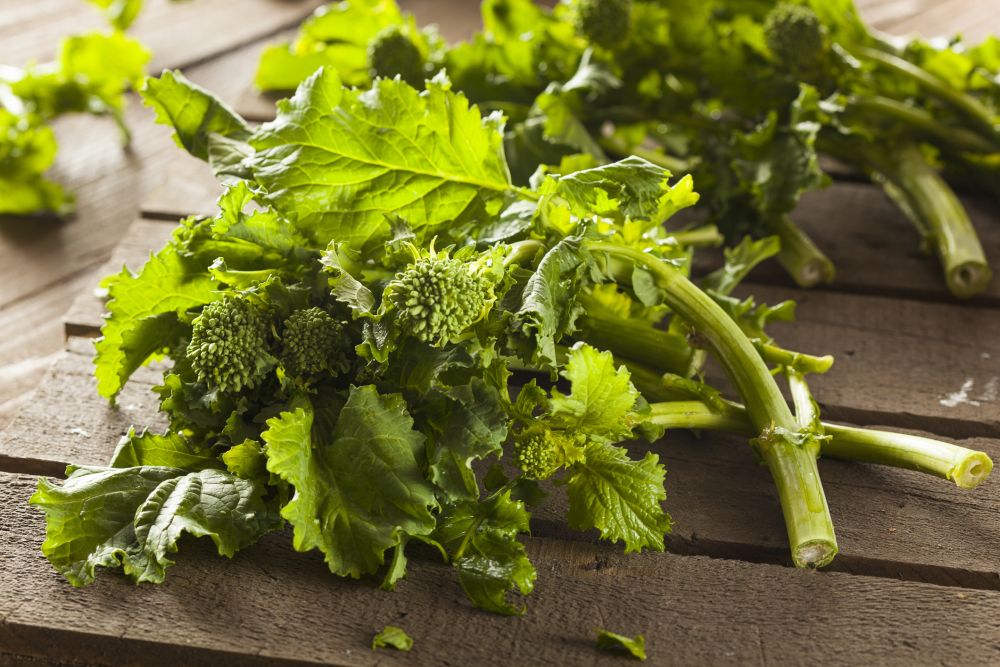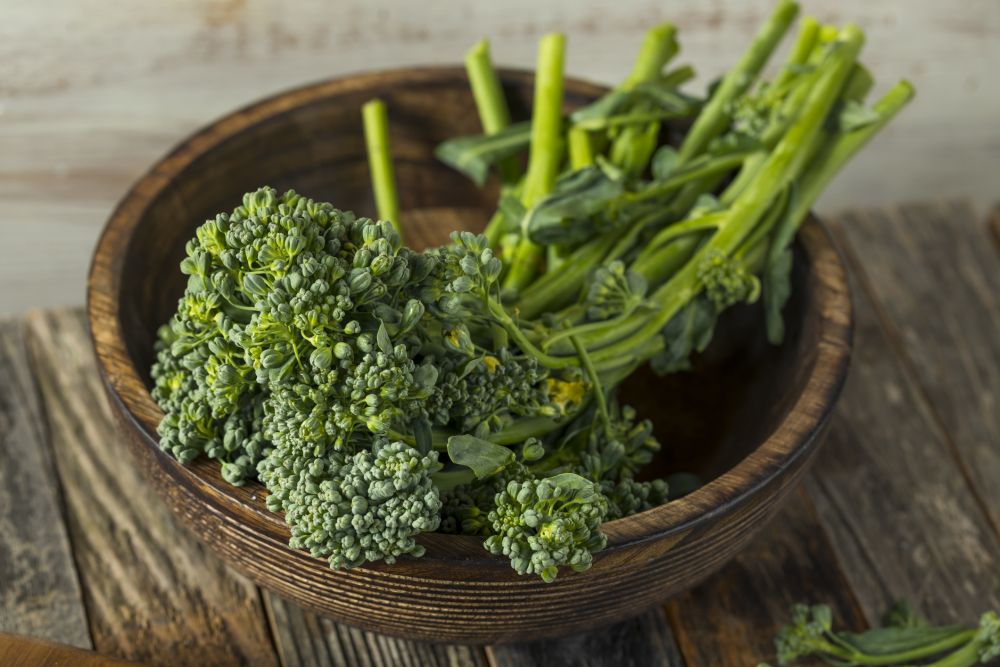Broccoli Rabe Care – How To Grow And Harvest Rapini
Broccoli Rabe is a good alternative for people who don’t like the sandy texture of regular broccoli. And unlike broccoli, you’re not limited to the head of flower buds. In fact, you can eat the leaves, stems, as well as the small clusters of buds.
You’ll get the same health benefits from eating any part of broccoli rabe. So if you’re not a fan of the green and gritty buds, you can use the leaves in different cooking styles and reap the benefits. But since it’s not as popular as broccoli, especially in grocery stores, chances are you can only find it in your local branch of Whole Foods and other similar stores. Another option is to grow it in your garden. That way you can choose which variety to grow and keep yourself stocked with the fresh veggie. Read on to find out how to grow, care for, and harvest broccoli rabe.
All about Broccoli Rabe
Originally from Europe, broccoli rabe (Brassica rapa) is a cool climate vegetable with a nutty and slightly pungent flavor. Some people compare the taste to that of turnips and even mustard. There’s no surprise there since broccoli rabe is more related to turnips than broccoli. It goes by many names including rapini and broccoli raab.
As a green cruciferous veggie, rapini has slender leaves similar to kale and small clusters of buds at the top that remind you of broccoli. It favors cool weather and has a fast growth rate. And similar to broccoli and kale, it is packed with nutrients and health benefits. The leafy green vegetable is rich in protein, iron, calcium, manganese, and dietary fiber. It also has more antioxidants than broccoli.
While it’s mainly popular in Italian, Greek, and Portuguese cuisines, rapini deserves a place on your table as well. You can eat it sauteed or braised or use it as a side dish along with pasta and Italian sausage. Its slightly bitter taste discourages people from eating it raw but it adds a wonderful flavor to soups and stews.
Broccoli Rabe Varieties
For a vegetable that barely has any presence outside of Italian restaurants, broccoli rabe does have a lot of varieties. One of the advantages of growing your own rapini is you can choose which variety to grow and explore more than one variety at once. It’s an easy way to expand your culinary horizons without being limited by the options at the grocery store. Here are some recommended broccoli rabe varieties for your veggie patch.
- Zamboni: The leaves of this Italian cultivar are rather tender while the heads of buds are larger than other rapini varieties. It has a fast growth rate and is ready to harvest within 45 days in the right conditions. This cultivar is popular because it’s quite productive and the side shoots are just as tasty as the main head.
- Sessantina: Another cultivar known for its fast growth rate. It is ready to harvest in about 35 days. The mature plant is 14 inches high and has smaller bud clusters that grow atop tender stalks. The veggie prefers cool temperatures and apart from the summer, you can grow it all year round.
- Spring Raab: This cultivar needs about 45 days to become ready to harvest. It has mild-tasting leaves and is bolting-resistant. You can grow it in warm zones in the early spring and harvest it before the summer.
- Super Rapini: A productive cultivar that matures within 60 days. The patch grows and matures together, so you’ll need to plant small patches and plant multiple times to keep yourself stocked up on the veggie. It has a short harvesting window and might start to flower before the foliage has fully developed.
- Hon Tsai Tai: An Asian cultivar that matures in about 37 days. You can either plant it in the early summer for a late summer harvest or in mid-summer and harvest it in the early winter. A small and compact variety, it grows purple stems with buds that taste like mustard.
- Novantina: A large cultivar by rapini standards. It reaches about 18 inches high and has large leaves and thick stems to match. It takes about 55 days to mature and is suitable for all seasons except for the winter.
- Spigariello: If the main reason you’re growing broccoli raab rather than good old broccoli is that you’d like to harvest more leaves than bud clusters, then this cultivar is the one for you. It grows more leaves than buds. The smooth leaves are a good addition to stews and soups.
How to Grow Broccoli Rabe
One of the most appealing qualities of broccoli rabe is that you can grow it both as a potted plant or in the garden. It doesn’t take long for the plant to mature depending on the cultivar you choose and some varieties are good to grow any time of the year. Here’s how to start broccoli rabe from seeds in easy steps.
- You can start the seeds either in early spring or late summer. If you’re starting in the spring, wait for the last frost to pass.
- Select a spot in the garden that gets about 6 hours of sunlight a day.
- Break the top 5 inches of the soil and mix in organic materials to improve the soil texture.
- Create rows about 18 inches apart, each row about 12 inches high.
- Plant the seed a half-inch deep and cover it lightly with soil. Don’t pack the soil.
- Space the seeds two inches apart.
- Water the patch to get the soil moist. Keep it moist until the seeds germinate.
- When the seedlings are about 3 inches tall, thin them out to keep 6 inches between each seedling. This gives the plants more room to grow and prevents premature bolting.
If you’re growing broccoli rabe in a container due to limited space, you can use a wide planter and follow the above steps. Keep the seeds well-spaced since competitiveness over resources triggers the veggie to focus on growing buds rather than leaves. The bud clusters will go to seed quickly in these conditions. After bolting the leaves become bitter and inedible.
Broccoli Rabe Care
Broccoli rabe takes as much care as broccoli, turnip or similar vegetables. But with the added fast growth rate, before you know it, your veggie is ready to harvest. And since you can grow different varieties all year round, if you lose a harvest or the veggies go to seed quickly, just uproot them and start a new patch.
Soil
Rapini loves well-drained soil. Its roots are shallow so the texture of the soil needs to be loose to help the root ball grow fast and support the fast-growing plant. If you have loamy soil in your garden then you won’t need to amend it. But clay or sandy soil both need to be fixed before you can plant your vegetable. Mixing clay soil with both organic materials and coarse sand would give it the right texture. The pH of the soil needs to be between 6.0 and 7.0. Slightly acidic soil contributes to the pungent flavor of the leaves and buds of this healthy veggie.
Fertilizer
As a heavy feeder, broccoli rabe needs plenty of nutrients. If the soil is poor and lacks essential nutrients, mend it before you sow the seeds. Otherwise, the plant will struggle and take longer to harvest. Growing in rich soil gives the veggie a good start but that’s hardly enough. You’ll need to side-dress once a week with a custom 10-3-10 fertilizer that’s rich in nitrogen but has less phosphorus. Nitrogen encourages the plant to grow stems and leaves while the absence of phosphorus delays the growth of the bud clusters. Apply the fertilizer once a week until the vegetable is ready to harvest.
Water
You’ll need to keep the soil moist throughout the life of the veggie. From the moment you plant the seeds in the soil until you harvest the succulent leaves, the soil has to be constantly moist. Broccoli rabe has a low tolerance for dry soil and the signs of drought stress vary and include drooping leaves and wilting stems. At the same time, the roots of rapini don’t do well in wet soil. Crown rot sets in quickly if the plant sits in waterlogged soil for long. You might have to water it every day if the soil dries out quickly. Water in the early morning and avoid getting the leaves, buds, or stems wet.
Pruning
This is actually more pinching than pruning. Wait for the first stem to develop a bud before you pinch its head. This has many benefits. It prevents that first stalk from going to seed quickly before the plant has developed its foliage. At the same time, the pinched stalk triggers more side shoots which gives you a more robust veggie with plenty of leaves and shoots. Some cultivars that grow more bud heads than leaves also benefit from this as they tend to develop more side heads.
Mulch
If the soil dries out quickly and you think the plants are not getting enough moisture, then you can cover the rows with mulch. Mulch helps with moisture retention, suppresses weeds, and prevents the spread of pests. Use any organic mulching available for you. Shredded bark, hay, straw, or grass clippings are all good mulching materials. Lay the mulch in a 2-inch thick layer along the rows and make sure it doesn’t get in contact with the base of the vegetables.
Pests and Diseases
Much like broccoli and turnips, broccoli rabe is susceptible to some common pests such as aphids, cutworms, and cabbage worms. Since this is an edible vegetable, you’ll need to be vigilant and get rid of these pests as soon as you spot them crawling along with the leaves. Aphids target the leaves of rapini while both cabbage worms and cutworms feed on every part of the plant including the stems and leaves. Treat the infected vegetables with neem oil spray. If one plant is too ruined by the bugs, remove it and dispose of it safely. Spray the other plants around it with neem oil before they meet the same fate.
Harvesting Broccoli Rabe
Harvest time for broccoli rabe varies. Some cultivars mature in as little as 30 days while others could take up to 70 days in the soil before you can harvest the leaves and heads. For the most part, you can start collecting the fresh leaves once they reach between 6 to 10 inches long.
To harvest the leaves, you can use your hand or a sharp blade to cut the leaf where it meets the stem. As for the heads, they are rather brittle. So you’ll need to use sharp pruning shears. Cut the stem a few inches below the head preferably with some leaves along with it.
Don’t delay your harvest especially if the weather gets warmer and temperature rises above 75 degrees F. These are ideal conditions for the vegetable to go to seed where it becomes inedible.

